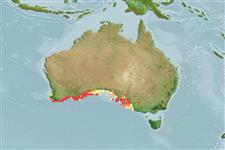Actinopterygii (ray-finned fishes) >
Syngnathiformes (Pipefishes and seahorses) >
Syngnathidae (Pipefishes and seahorses) > Syngnathinae
Etymology: Phycodurus: Greek, phykon = seaweed + Greek, dora = skin (Ref. 45335).
Environment / Climate / Range
Ecology
Marine; reef-associated; non-migratory; depth range 4 - 30 m (Ref. 9002). Temperate, preferred ?; 32°S - 39°S, 115°E - 140°E (Ref. 57011)
Eastern Indian Ocean: endemic to southern Australia.
Size / Weight / Age
Maturity: Lm ? range ? - ? cm
Max length : 35.0 cm TL male/unsexed; (Ref. 9002)
Usually occur over sand patches close to reefs with kelp, feeding on mysids and other crustaceans. Ovoviviparous (Ref. 205). The male carries the eggs in a brood pouch which is found under the tail (Ref. 205). One of the most spectacular examples of camouflage: neither prey nor predators recognize it as a fish.
Life cycle and mating behavior
Maturity | Reproduction | Spawning | Eggs | Fecundity | Larvae
About 250 eggs are incubated by males on the underside of the tail, where they are embedded in spongy tissue (Ref. 31838).
Kuiter, R.H., 1993. Coastal fishes of south-eastern Australia. University of Hawaii Press. Honolulu, Hawaii. 437 p. (Ref. 9002)
IUCN Red List Status (Ref. 115185)
CITES (Ref. 94142)
Not Evaluated
Threat to humans
Harmless
Human uses
Fisheries: of no interest; aquarium: commercial
More information
Age/SizeGrowthLength-weightLength-lengthLength-frequenciesMorphometricsMorphologyLarvaeLarval dynamicsRecruitmentAbundance
ReferencesAquacultureAquaculture profileStrainsGeneticsAllele frequenciesHeritabilityDiseasesProcessingMass conversion
Tools
Special reports
Download XML
Internet sources
